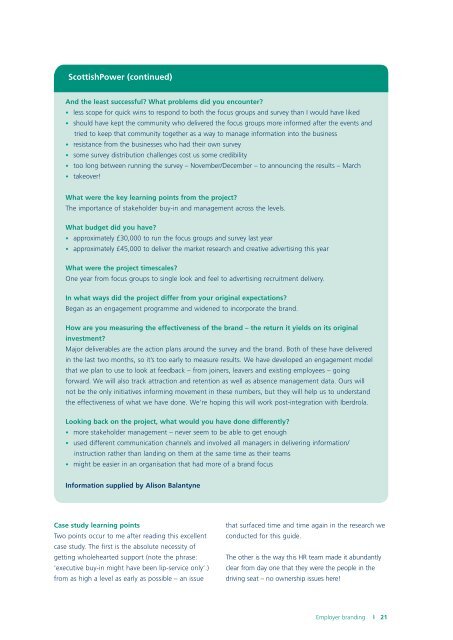Employer branding A no-nonsense approach - CIPD
Employer branding A no-nonsense approach - CIPD
Employer branding A no-nonsense approach - CIPD
You also want an ePaper? Increase the reach of your titles
YUMPU automatically turns print PDFs into web optimized ePapers that Google loves.
ScottishPower (continued)<br />
And the least successful? What problems did you encounter?<br />
• less scope for quick wins to respond to both the focus groups and survey than I would have liked<br />
• should have kept the community who delivered the focus groups more informed after the events and<br />
tried to keep that community together as a way to manage information into the business<br />
• resistance from the businesses who had their own survey<br />
• some survey distribution challenges cost us some credibility<br />
• too long between running the survey – November/December – to an<strong>no</strong>uncing the results – March<br />
• takeover!<br />
What were the key learning points from the project?<br />
The importance of stakeholder buy-in and management across the levels.<br />
What budget did you have?<br />
• approximately £30,000 to run the focus groups and survey last year<br />
• approximately £45,000 to deliver the market research and creative advertising this year<br />
What were the project timescales?<br />
One year from focus groups to single look and feel to advertising recruitment delivery.<br />
In what ways did the project differ from your original expectations?<br />
Began as an engagement programme and widened to incorporate the brand.<br />
How are you measuring the effectiveness of the brand – the return it yields on its original<br />
investment?<br />
Major deliverables are the action plans around the survey and the brand. Both of these have delivered<br />
in the last two months, so it’s too early to measure results. We have developed an engagement model<br />
that we plan to use to look at feedback – from joiners, leavers and existing employees – going<br />
forward. We will also track attraction and retention as well as absence management data. Ours will<br />
<strong>no</strong>t be the only initiatives informing movement in these numbers, but they will help us to understand<br />
the effectiveness of what we have done. We’re hoping this will work post-integration with Iberdrola.<br />
Looking back on the project, what would you have done differently?<br />
• more stakeholder management – never seem to be able to get e<strong>no</strong>ugh<br />
• used different communication channels and involved all managers in delivering information/<br />
instruction rather than landing on them at the same time as their teams<br />
• might be easier in an organisation that had more of a brand focus<br />
Information supplied by Alison Balantyne<br />
Case study learning points<br />
Two points occur to me after reading this excellent<br />
case study. The first is the absolute necessity of<br />
getting wholehearted support (<strong>no</strong>te the phrase:<br />
‘executive buy-in might have been lip-service only’.)<br />
from as high a level as early as possible – an issue<br />
that surfaced time and time again in the research we<br />
conducted for this guide.<br />
The other is the way this HR team made it abundantly<br />
clear from day one that they were the people in the<br />
driving seat – <strong>no</strong> ownership issues here!<br />
<strong>Employer</strong> <strong>branding</strong>

















